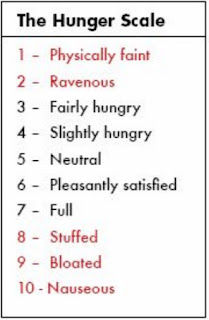Use The Hunger Scale as a tool for weight-loss.
A typical scenario for an adult woman attempting to lose weight: She wakes up feeling full of will-power and ready to start her diet. She skips breakfast in an attempt to reduce calories. Ignoring her hunger, she has a very light lunch (salad and water) and feels happy she was able to ignore the hunger and stay below 400 calories for the day so far. As the afternoon wears on, she becomes tired and fatigued (lack of food energy!), so she reaches for a 5-hour Energy shot to perk up. 5pm rolls around, and the hunger feelings have taken over her rational thoughts. She feels cranky and tired so she stops by Starbucks on the way home from work to grab a Venti Frapaccino. When she arrives home, she starts dinner while snacking on some Girl Scout cookies her daughter's troop was selling. She also samples dinner as she cooks. When dinner is ready, she piles her plate full of food, and feeling ravenous, finishes every bite in 10 minutes. Still feeling hungry, she goes back for seconds and finishes that too. A half-hour later, she feels bloated and stuffed, wishing she did not eat so much. Time for some Pepto. As the evening goes on, the kids decide to have some ice cream. She thinks to herself, "I skipped breakfast and had a healthy lunch, so I deserve some ice cream too". Still full from dinner, she eats a cup of ice cream with chocolate syrup.
Many unwanted calories are eaten when we do not listen to our hunger cues. We eat when we are not hungry because we may be happy, sad, stressed, socializing, celebrating, or mourning. We don't eat when we are hungry because we are busy, sad, stressed, on diets, etc. Use the chart above and the descriptions below to help you determine your stage of hunger. This will help you in your weight loss/weight management goals. Hang the Hunger Scale chart in your office, on your refrigerator, or in your pantry as a friendly reminder.
The Stages of The Hunger Scale
1. Physically faint from hunger: You may have a headache. You can’t concentrate and feel dizzy. You may have trouble with coordination. You are totally out of energy and need to lie down. This may happen during a very restrictive diet.
2. Ravenous: You are famished. You’re irritable, cranky and have little energy.
Do not let yourself get to a 1 or 2. It is at these stages where we make poor food choices & overeat. We then find ourselves uncomfortably full at a 9 or 10.
3. Fairly Hungry: You have a strong urge to eat. You are feeling an emptiness in your stomach and your stomach is "growling". This might be a good time to start eating.
4. Slightly Hungry: You start to think about food. Your body is giving you the signal that you might want to eat. You are a little hungry.
5. Neutral: Your body has enough fuel to keep it going and is physically and psychologically nearly satisfied.
6. Pleasantly satisfied: You’re fully at the point of satisfaction. It is time to stop eating.
7. Full: You’re past the point of satisfaction. You should have stopped eating by now.
Stages 3 through 7 are the safest stages. We should not let ourselves get hungrier than a 3 and we should avoid letting ourselves overeat past a 7.
8. Stuffed: You are actually starting to hurt (need to unbuckle your pants?). Maybe you shouldn’t have had more, but it tasted so good. 9. Bloated: You overate, and need to grab the Pepto or Rolaids and sit down for a while. The after-effects feel really uncomfortable. This often happens at a buffet or "all-you-can-eat" event. Maybe you didn’t eat all day, got yourself to a 1 or 2 on the Hunger Scale, ate too much too quickly, and ended up here at a 9.
10. Nauseous: BEYOND FULL. Think Thanksgiving Day. You are physically miserable, don’t want to or can’t move, and feel like you never want to look at food again. (Food Coma)
Obviously, we want to avoid Stages 8, 9, & 10 because over-eating and large portions lead to weight gain...plus, it just plain hurts!
Avoid playing the Hunger Game. Try using the Hunger Scale today. See if you can break the vicious cycle of letting yourself get ravenously hungry and then overeating until you are stuffed and bloated. It will help you feel better and also help control your weight.
"May the odds be ever in your favor."


